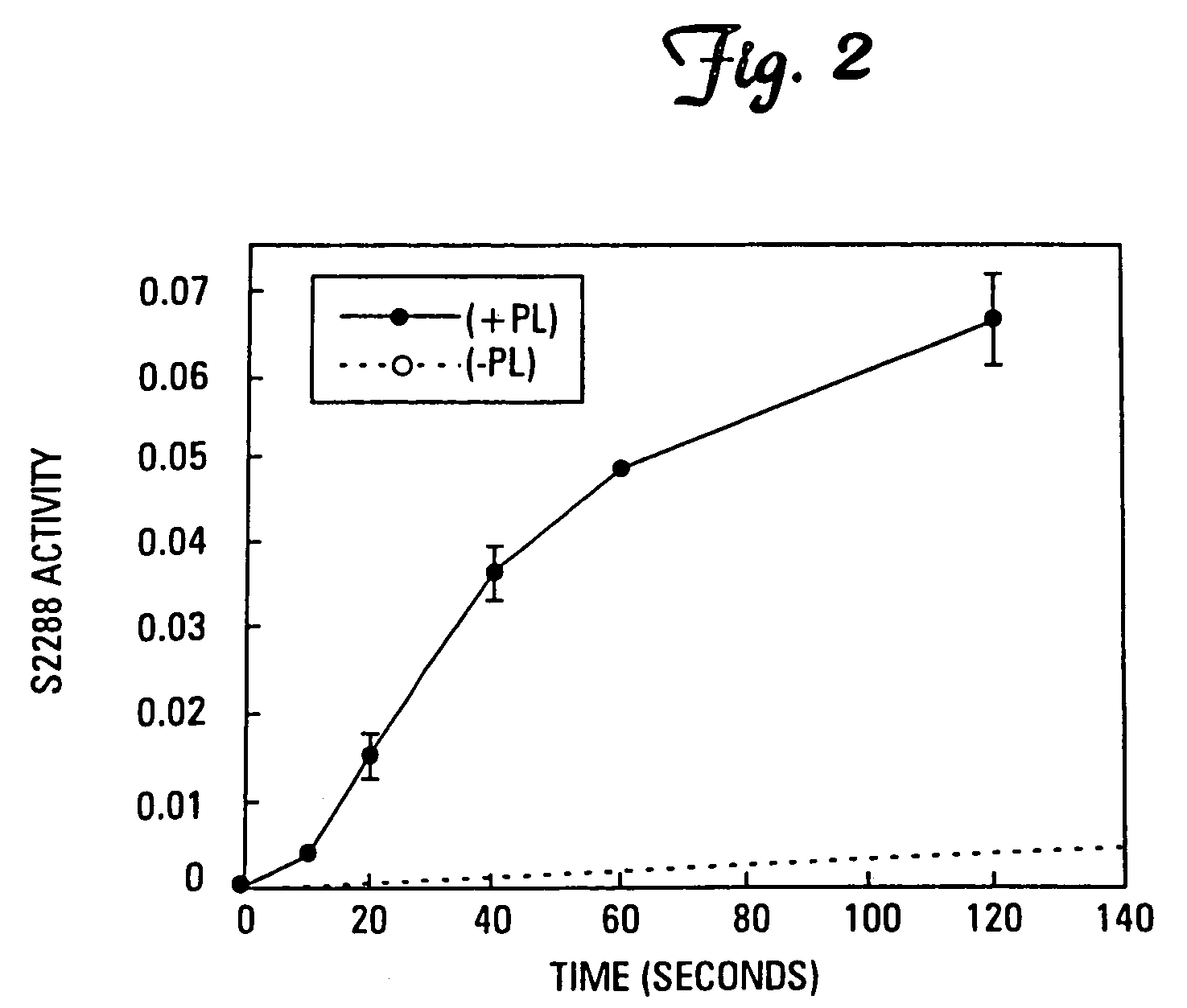Modified vitamin K-dependent polypeptides
a technology of vitamin k and polypeptides, applied in the field of modified vitamin k-dependent polypeptides, can solve the problems of limited factor viii replacement therapy, and achieve the effects of enhancing activity, enhancing membrane binding affinity, and effective treatment of deficiency states
- Summary
- Abstract
- Description
- Claims
- Application Information
AI Technical Summary
Benefits of technology
Problems solved by technology
Method used
Image
Examples
example 1
Factor VII with Enhanced Membrane Affinity and Activity
[0076]It has been found that the membrane binding affinity of human blood clotting factor VII can be increased by site-directed mutagenesis. The properties of a P11Q,K33E mutant (referred to herein as Factor VIIQ11E33 or mutant factor VII) have been characterized. Membrane affinity was increased over wild type protein by about 20-fold. Autoactivation by the mutant was increased by at least 100-fold over that of wild type factor VII. The activated form of VIIQ11E33 (referred to as VIIaQ11E33) displayed about 10-fold higher activity toward factor X. The coagulation activity of VIIaQ11E33 with soluble tissue factor in normal plasma was about 10-fold higher than that of wild type VIIa. Coagulation activity of the zymogen, VIIQ11E33, with normal tissue factor (supplied as a 1:100 dilution of thromboplastin-HS), was 20-fold higher than wild type Factor VII. The degree to which activity was enhanced was dependent on conditions, with V...
example 2
Purification of Factor VII
[0097]Factor VII (wild-type or mutant) was purified by Conconavalin A (Con A), DEAE, and affinity chromatography. Crude media of transfected 293 cells were incubated with Con A resin (Pharmacia) for four hours at 4° C. The resin then was washed with a solution containing 50 mM Tris, pH 7.5, 10 mM benzamidine, 1 mM CaCl2, and 1 mM MgCl2, and factor VII was eluted with 0.2 M D-methyl mannoside, 0.5 M NaCl in 50 mM Tris buffer, pH 7.5. Factor VII was dialyzed against 50 mM Tris, pH 8.0, 50 mM NaCl, 10 mM benzamidine, and 25 mM D-methyl mannoside overnight.
[0098]Dialyzed factor VII then was incubated with DEAE resin (Pharmacia) for one hour and the mixture was packed into a column. The DEAE column was washed with 50 mM Tris, pH 8.0, 10 mM Benzamidine, and 50 mM NaCl, and factor VII was eluted with a gradient from 50 mM to 500 mM NaCl in 50 mM Tris buffer, pH 8.0 at a flow rate of 2 mL / min. Fractions containing factor VII activity were pooled and dialyzed agains...
example 3
Circulatory Time of Factor VIIQ11E33 in the Rat
[0107]Two anesthetized (sodium nembutol) Sprague Dawley rats (325-350 g) were injected with 36 μg of factor VIIQ11E33 at time zero. Injection was through the juggler vein, into which a cannula had been placed. At the times shown in FIG. 7, blood was withdrawn from the carotid artery, into which a cannula had been inserted by surgery. The amount of factor VIIQ11E33 in the circulation was estimated from the clotting time of human factor VII-deficient plasma, to which 1 μL of a 1:10 dilution of the rat plasma was added. A 1:100 dilution of rabbit brain thromboplastin-HS (Sigma Chemical Co.) was used. Coagulation was assessed by the manual tube tilt method as described in Example 1. The amount of factor VII activity in the plasma before injection of VIIQ11E33 was determined and was subtracted as a blank. The concentration of factor VIIQ11E33 in the circulation is given as log nM. A sham experiment in which a third animal received the opera...
PUM
| Property | Measurement | Unit |
|---|---|---|
| Acidity | aaaaa | aaaaa |
| Affinity | aaaaa | aaaaa |
Abstract
Description
Claims
Application Information
 Login to View More
Login to View More - R&D
- Intellectual Property
- Life Sciences
- Materials
- Tech Scout
- Unparalleled Data Quality
- Higher Quality Content
- 60% Fewer Hallucinations
Browse by: Latest US Patents, China's latest patents, Technical Efficacy Thesaurus, Application Domain, Technology Topic, Popular Technical Reports.
© 2025 PatSnap. All rights reserved.Legal|Privacy policy|Modern Slavery Act Transparency Statement|Sitemap|About US| Contact US: help@patsnap.com



